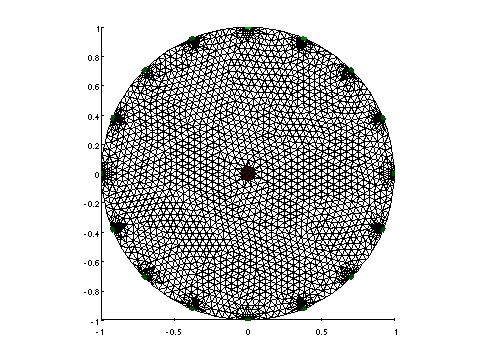

|
EIDORS: Electrical Impedance Tomography and Diffuse Optical Tomography Reconstruction Software |
|
EIDORS
(mirror) Main Documentation Tutorials − Image Reconst − Data Structures − Applications − FEM Modelling − GREIT − Old tutorials − Workshop Download Contrib Data GREIT Browse Docs Browse SVN News Mailing list (archive) FAQ Developer
|
GREIT evaluation: Make simulation data (2D)In order to test the performance of GREIT, we create a set of simulation data. Here we look at the performance for an object moving radially toward the side from the centre of the medium.Prepare simulation data: create phantom model in 2DPrepare Model
% create model $Id: simulate_2d_test01.m 3828 2013-04-13 14:20:17Z bgrychtol $
% Model parameters
n_elec= 16;
n_nodes= 2000;
% Create electrodes
refine_level=4; %electrode refinement level
elec_width= .1;
z_contact = 0.01;
% elect positions
th=linspace(0,2*pi,n_elec(1)+1)';th(end)=[];
elec_posn= [sin(th),cos(th)];
[elec_nodes, refine_nodes] = dm_mk_elec_nodes( elec_posn, elec_width, refine_level);
% Define circular medium
fd=inline('sum(p.^2,2)-1','p');
bbox = [-1,-1;1,1];
smdl = dm_mk_fwd_model( fd, [], n_nodes, bbox, elec_nodes, refine_nodes, z_contact);
smdl = mdl_normalize(smdl,0);
Calculate Homogeneous simulations
% simulate homogeneous $Id: simulate_2d_test02.m 3273 2012-06-30 18:00:35Z aadler $
% stimulation pattern: adjacent
stim_pat= mk_stim_patterns(n_elec,1,'{ad}','{ad}',{},1);
smdl.stimulation= stim_pat;
himg= mk_image(smdl,1);
vh= fwd_solve(himg); vh= vh.meas;
Prepare simulation data: create phantom model in 2DThe positions of the simulated objects may be seen here:% moving target $Id: simulate_2d_test03.m 3828 2013-04-13 14:20:17Z bgrychtol $ % Create a moving object within the model trg_rad= 0.05; trs= trg_rad*sin(th); trc= trg_rad*cos(th); radius= 0.9; n_sims= 2 ; contrast= 0.1; vi=[]; for i= 1:n_sims; f_frac = (i-1)/(n_sims-1); cv= 2*pi*f_frac * 73; trg_ctr= f_frac*radius*[cos(cv),sin(cv)]; trg_refine_nodes= [refine_nodes; [ trs+trg_ctr(1), trc+trg_ctr(2) ]]; tmdl= dm_mk_fwd_model( fd, [], n_nodes, bbox, elec_nodes, trg_refine_nodes, z_contact); tmdl.stimulation = stim_pat; tmdl = mdl_normalize(tmdl,0); % find elements in size target mdl_pts = interp_mesh( tmdl ); ctr_pts = mdl_pts - ones(size(mdl_pts,1),1)*trg_ctr; in_trg =(sum(ctr_pts.^2,2) < trg_rad^2); % Create target image object timg= mk_image(tmdl, 1 + in_trg*contrast); vi_t= fwd_solve(timg); vi = [vi, vi_t.meas]; if i==1; show_fem(timg); print -dpng -r60 simulate_2d_test03a.png elseif i==150; show_fem(timg); print -dpng -r60 simulate_2d_test03b.png end end 
Figure: Position and size of conductive targets in medium |
Last Modified: $Date: 2017-02-28 13:12:08 -0500 (Tue, 28 Feb 2017) $ by $Author: aadler $